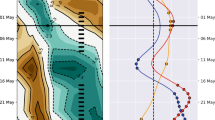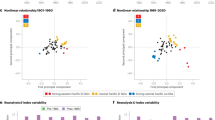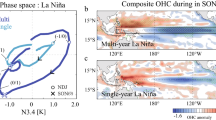Abstract
The El Niño/Southern Oscillation (ENSO) is characterized by changes in sea surface temperature (SST) and atmospheric convection in the tropical Pacific, and modulates global weather and climate1,2,3,4. The phase of ENSO influences United States (US) temperature and precipitation and has long been hypothesized to influence severe thunderstorm occurrence over the US5,6,7,8,9,10,11. However, limitations12 of the severe thunderstorm observational record, combined with large year-to-year variability12,13, have made it difficult to demonstrate an ENSO influence during the peak spring season. Here we use environmental indices14,15,16 that are correlated with tornado and hail activity, and show that ENSO modulates tornado and hail occurrence during the winter and spring by altering the large-scale environment. We show that fewer tornadoes and hail events occur over the central US during El Niño and conversely more occur during La Niña conditions. Moreover, winter ENSO conditions often persist into early spring, and consequently the winter ENSO state can be used to predict changes in tornado and hail frequency during the following spring. Combined with our current ability to predict ENSO several months in advance17, our findings provide a basis for long-range seasonal prediction of severe thunderstorm activity.
This is a preview of subscription content, access via your institution
Access options
Subscribe to this journal
Receive 12 print issues and online access
$259.00 per year
only $21.58 per issue
Buy this article
- Purchase on Springer Link
- Instant access to full article PDF
Prices may be subject to local taxes which are calculated during checkout




Similar content being viewed by others
References
Ropelewski, C. F. & Halpert, M. S. Global and regional scale precipitation patterns associated with the El Niño/Southern Oscillation. Mon. Weath. Rev. 115, 1606–1626 (1987).
Halpert, M. S. & Ropelewski, C. F. Surface temperature patterns associated with the Southern Oscillation. J. Clim. 5, 577–593 (1992).
Eichler, T. & Higgins, W. Climatology and ENSO-related variability of North American extratropical cyclone activity. J. Clim. 19, 2076–2093 (2006).
Lee, S-K., Mapes, B. E., Wang, C., Enfield, D. B. & Weaver, S. J. Springtime ENSO phase evolution and its relation to rainfall in the continental U.S. Geophys. Res. Lett. 41, 1673–1680 (2014).
Galway, J. G. Relationship between precipitation and tornado activity. Wat. Resour. Bull. 15, 961–964 (1979).
Rhomel, J. R., Niyogi, D. & Raman, S. Mesoclimatic analysis of severe weather and ENSO interactions in North Carolina. Geophys. Res. Lett. 27, 2269–2272 (2000).
Marzban, C. & Schaefer, J. T. The correlation between U.S. tornadoes and Pacific sea surface temperatures. Mon. Weath. Rev. 129, 884–895 (2001).
Cook, A. R. & Schaefer, J. T. The relation of El Niño–Southern Oscillation (ENSO) to winter tornado outbreaks. Mon. Weath. Rev. 136, 3121–3137 (2008).
Shepherd, M., Niyogi, D. & Mote, T. L. A seasonal-scale climatological analysis correlating spring tornadic activity with antecedent fall–winter drought in the southeastern United States. Environ. Res. Lett. 4, 024012 (2009).
Weaver, S. J., Baxter, S. & Kumar, A. Climatic role of North American low-level jets on US regional tornado activity. J. Clim. 25, 6666–6683 (2012).
Lee, S-K., Atlas, R., Enfield, D. B., Wang, C. & Liu, H. Is there an optimal ENSO pattern that enhances large-scale atmospheric processes conducive to major tornado outbreaks in the U.S.? J. Clim. 26, 1626–1642 (2013).
Verbout, S. M., Brooks, H. E., Leslie, L. M. & Schultz, D. M. Evolution of the U.S. tornado database: 1954–2003. Weath. Forecast. 21, 86–93 (2006).
Doswell, C. A. Small sample size and data quality issues illustrated using tornado occurrence data. Electron. J. Severe Storms Meteorol. 2, 1–16 (2007).
Tippett, M. K., Sobel, A. H. & Camargo, S. J. Association of U.S. tornado occurrence with monthly environmental parameters. Geophys. Res. Lett. 39, L02801 (2012).
Tippett, M. K., Sobel, A. H., Camargo, S. J. & Allen, J. T. An empirical relation between U.S. tornado activity and monthly environmental parameters. J. Clim. 27, 2983–2999 (2014).
Allen, J. T., Tippett, M. K. & Sobel, A. H. Associating monthly hail occurrence and large scale environment for the Continental United States. J. Adv. Model. Earth Syst. 7, http://dx.doi.org/10.1002/2014MS000397 (2015).
Barnston, A. G., Tippett, M. K., L’Heureux, M. L., Shuhua, L. & DeWitt, D. G. Skill of real-time seasonal ENSO model predictions during 2002–11: Is our capability increasing? Bull. Am. Meteorol. Soc. 93, 631–651 (2012).
Barrett, B. S. & Gensini, V. A. Variability of central United States April–May tornado day likelihood by phase of the Madden–Julian Oscillation. Geophys. Res. Lett. 40, 2790–2795 (2013).
Munich RE, Severe Weather in North America Munich RE Report Number 302-07563, 274 (Munich RE, 2013).
Brooks, H. E., Lee, J. W. & Craven, J. P. The spatial distribution of severe thunderstorm and tornado environments from global reanalysis data. Atmos. Res. 68, 73–94 (2003).
Gensini, V. A. & Ashley, W. S. Climatology of potentially severe convective environments from North American regional reanalysis. Electron. J. Severe Storms Meteorol. 6, 1–40 (2011).
Allen, J. T. & Karoly, D. J. A climatology of Australian severe thunderstorm environments 1979–2011: Inter-annual variability and ENSO influence. Int. J. Climatol. 34, 81–97 (2014).
Diffenbaugh, N. S., Scherer, M. & Trapp, R. J. Robust increases in severe thunderstorm environments in response to greenhouse forcing. Proc. Natl Acad. Sci. USA 110, 16361–16366 (2013).
Tippett, M. K., Allen, J. T., Gensini, V. A. & Brooks, H. E. Climate and hazardous convective weather. Curr. Clim. Change Rep. (in the press, 2014).
Karl, T. R. & Koss, W. J. Regional and National Monthly, Seasonal, and Annual Temperature Weighted by Area, 1895–1983 38 (Historical Climatology Series 4-3, National Climatic Data Center, 1984).
Climate Prediction Center. Changes to the Oceanic Niño Index (2014); http://www.cpc.ncep.noaa.gov/products/analysis_monitoring/ensostuff/ensoyears.shtml
Wilks, D. S. Extending logistic regression to provide full-probability-distribution MOS forecasts. Meteorol. Appl. 16, 361–368 (2009).
Schaefer, J. T. & Edwards, R. The SPC tornado/severe thunderstorm database. Am. Meteorol. Soc. 215–220 (1999).
Mesinger, F. et al. North American regional reanalysis. Bull. Am. Meteorol. Soc. 87, 343–360 (2006).
Epstein, E. S. A scoring system for probability forecasts of ranked categories. J. Appl. Meteorol. 8, 985–987 (1969).
Acknowledgements
The authors are supported by grants from the National Oceanic and Atmospheric Administration (NA05OAR4311004 and NA14OAR4310185), the Office of Naval Research (N00014-12-1-0911) and a Columbia University Research Initiatives for Science and Engineering (RISE) award. The views expressed herein are those of the authors and do not necessarily reflect the views of NOAA or any of its sub-agencies.
Author information
Authors and Affiliations
Contributions
J.T.A. carried out production of all results and led writing of the paper and research design. M.K.T. contributed to the research design and assisted with statistical analysis. All authors participated in the interpretation of results and the writing and editing process.
Corresponding author
Ethics declarations
Competing interests
The authors declare no competing financial interests.
Supplementary information
Supplementary Information
Supplementary Information (PDF 3423 kb)
Rights and permissions
About this article
Cite this article
Allen, J., Tippett, M. & Sobel, A. Influence of the El Niño/Southern Oscillation on tornado and hail frequency in the United States. Nature Geosci 8, 278–283 (2015). https://doi.org/10.1038/ngeo2385
Received:
Accepted:
Published:
Issue Date:
DOI: https://doi.org/10.1038/ngeo2385
This article is cited by
-
Unravelling ENSO complexity
Nature Geoscience (2023)
-
Using Extreme Value Theory to Assess the Mortality Risk of Tornado Outbreaks
International Journal of Disaster Risk Science (2023)
-
Using soil moisture and variability with respect to ENSO as a predictor for spring convective events within the State of Missouri, USA
Theoretical and Applied Climatology (2023)
-
Hails in Ny Alesund, Svalbard-atmospheric vertical structure and dependence on circulation
Natural Hazards (2023)
-
Skill of the Saudi-KAU CGCM in Forecasting ENSO and its Comparison with NMME and C3S Models
Earth Systems and Environment (2022)



